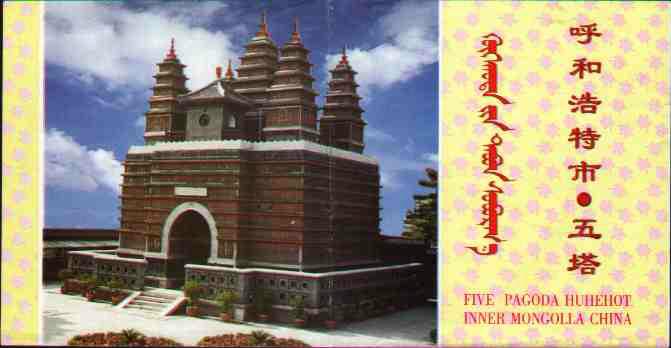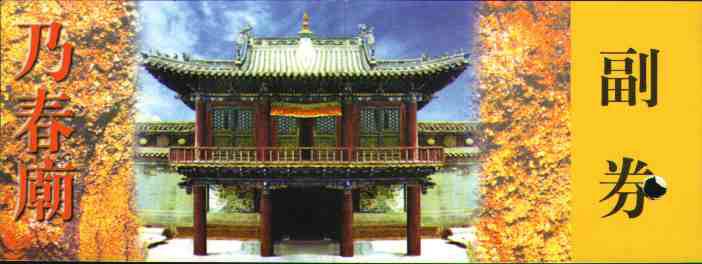

| Alfred C. Snider | April 15-16, 17, 18, 19, 20, 21, 22, 23, 24, 25, 26, 27, 2001| Other Journals | Debate Central |

Today is the day I am to interview the eight finalists to see which four students will attend the World Debate Institute. I am told that a morning of sightseeing is ahead of me, lunch, and then four hours of interviews.
I work on my journal and then go downstairs for breakfast. After breakfast I work on the questions and strategies I will use in interviewing students later today. I go downstairs to meet my two companion for the morning, students Sun Fei and Zhang Hui.
They have a car and a driver (I am later told this is the President of the university's car and driver) and we take off through the city. We soon move into the Old Town of Hohhot, where the streets are narrower, the buildings are more traditional, and there are fewer cars and more pedicabs, bicycles, and donkey drawn carts. There are many open air stalls on the sides of the road, offering fresh vegetables, spices, meat, clothing, housewares, shoes, and everything else you can imagine.
Five Pagoda Temple
We pull up in front of what looks like an impressive temple, but like none I have seen before. Sun Fei and Zhang Hui tell me it is called the Five Tower Pagoda, because of its obvious feature, and that it is a Buddhist shrine built in the Indian style but located far north of India here in Inner Mongolia.
We buy tickets and make our way into the compound, with the temple looming above us. We look at it from outside and then we enter a small door to begin the climb to the top. The passageway and stairway to the top are very narrow and cramped, and I can barely get my ungainly American bulk through it. Then, we emerge at the top and are standing on the ramparts of the temple, with the five pagoda towers looming above us. Each of the towers has incredibly intricate carvings on its red stone, many depicting characters from Buddhist lore. The lower carvings are protected by a metal screen because obviously people have been doing damage to them as wall as carving in initials and other markings.
The view from the top is excellent and provides a revealing vista of the nearby parts of Old Town, with many traditional mud brick buildings but also new high rise apartments which are being constructed as older brick buildings are demolished. It is clear, however, that each and every usable brick is being saved for use elsewhere.
After staying a while to interpret and imagine the meaning of the various carvings, we descend again into the courtyard around the temple. In a shop on the grounds I buy a traditional Mongolian pipe, a beautifully decorated traditional Mongolian hat, and a beautiful Mongolian wedding headdress to give as gifts when I return home.
Zhang Hui amd Sun Fei, Inner Mongolia debaters | Five Pagoda Temple
We leave the Five Pagoda Temple and take our car to another part of Old Town to visit a traditional Buddhist temple, which is still being used. It is tended by monks (I saw one using a mobile phone) and seemed to attract worshippers who burned incense, prayed, and left donations of money.

The architecture of the temple was impressive, but better still were the decorations inside. There were a number of huge traditional figures inside the buildings. I was very impressed by the statues of the "four kings" who guard the entrance to heaven. I like the blue-faced one the most, and he looked very ferocious.
Buddhist Temple in Hohhot, Inner Mongolia
Around the grounds were also placed a number of large "prayer wheels," which are metal cylinders containing large numbers of scrolls which contain prayers, and by turning the wheels it is thought that the prayers are activated and sent up to heaven. I tried to turn as many prayer wheels as I could (I can use all the help I can get). However, I did once turn the wheel the wrong way, and a helpful monk educated me. I am not sure turning it the wrong way activates a "rewind" function, but I was careful from then on always to turn them the right way.
Three of the "Four Kings" who guard heaven
There were also several beautiful wall paintings in the complex. I was especially struck by a beautiful wall painting which seemed to depict regions of the afterlife, from heavenly existence to a rather negatively portrayed existence in nine rings of what I will call "hell."
Touching ancient stones | Figure in the Buddhist Temple
We stop in a smaller building filled with wondrous statues, prayer wheels and decorations which is a shrine to longevity. I make a small donation, light a stick of incense, and offer a prayer for long life, not necessarily for myself, but for my two young companions Zhang Hui and Sun Fei. A monk watches me and seems to approve. In this shrine as in others photographs were not allowed, and I respected that request.
The final and most impressive display is in a large building which contains the main shrine. I walk around it and spin at least 50 prayer wheels. The central part of the shrine is a place where the monks meet and pray and chant together, and it is roped off. Around the edges of the shrine are huge statues and figures of Buddhist entities.
We left the Buddhist temple to continue our morning touring and headed for the Inner Mongolia Peoples' Museum. When we arrived we found that it is closed each Tuesday, so we made mental notes to try and return the next day and we headed back to the hotel.
Hohhot street scene, New Town
At the hotel I brought Zhang Hui and Sun Fei up to my room and we looked at the photos I had taken in Inner Mongolia, and we also got a chance just to chat. Both of them are fascinating young people with remarkable talents. We left the hotel and went back to our normal eating place across from the Administration building and the three of us had a very tasty lunch, once again full of interesting conversation. Because they are such talented English speakers I tried to use new words and slang in order to expand their knowledge. They also continued to tell me more and more about their native Inner Mongolia.
After lunch we went for a brief tour of the campus, and I especially wanted to see the library. It has about 1.2 million books and an extensive elibrary. We went to the English language section, which is where they often go to read because the magazines there do not circulate. We looked around the library a bit and then headed back to the Administration building which is where the interviews would be held. On the way we met party secretary Liang who asked about our day and wished me good luck during my interviews.
The interviews took place in a posh conference room with soft chairs, lovely tables, and beautiful wall hangings. Someone brought in hot water and prepared tea, and my first interviewee arrived right on time. I would interview eight students, each for thirty minutes, so I faced four solid hours of interviewing. I would be interviewing Jiao Ching, Tian Chao, Che Lulu, Sung Chien Lo, Gouxi Ping, Sun Fei, Zhang Hui, and Zhang Ji Hui.
While trying to get a general impression of each student and trying to give them opportunities to talk, there were specific things I was looking for. These factors were: English language skills, knowledge about current events and world affairs, and ability to invent ideas and responses (something debaters really need) In terms of experience public speaking background was also important. I had some stock questions which I asked to try and pursue these themes, and here are some of the answers.
It was a very difficult choice. Later that night I made my decision: (alphabetical order)
After the interviews I am joined by some of the students at dinner and we have a wonderful time and they do a great job educating me about the unusual dishes we are being served. After dinner they take me to the Yi Tai Hotel. I visit with some of the students for a while and then the official day is over.
I feel a cold coming on so I take extra vitamins and make a vow to get lots of sleep and drink lots of water.